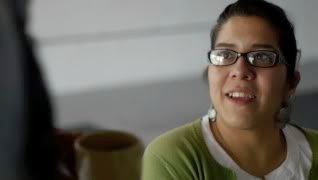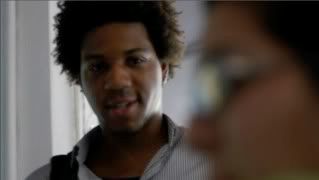I’m starting to get more into shooting video with my Panasonic Lumix GH1. I’ve been having a blast shooting stills with it since I bought it back in the fall. But because the freaky AVCHD format was not playing nice with my antiquated version of Final Cut Pro, I was really not shooting much video. I did, however, shoot my Luminaria project in that HD format, but I down-converted the files into standard definition to edit. And, a couple of months back, when I ordered an adapter to allow me to attached my old Nikon lenses to this faux-DSLR Micro Four Thirds camera, I started to play around with it a bit more. I shot a practice routine of URBAN-15, yet kept things in the SD format.
However, for this current project–an on-line commercial for C4 Workspace (the cool King William co-working space out of which I office)–I decided to shoot in the 1080p 24fps AVCHD format, and cut the whole thing in iMovie. For some strange reason, iMovie just loves AVCHD. The problem is, I don’t love iMovie. I’m having to teach myself how to use this silly program. But the truth is, it’s pretty damn advanced.
I’m having a blast shooting with my old Nikkor 50mm 1:18 lens that came with my Nikon FE I bought with my hard-earned money back when I was a teen photo geek in ’77 or ’78. This snazzy Panasonic Lumix has the CCD element pushed up to the front (this is the Micro Four Thirds deal–it makes the camera smaller and lighter than a true DSLR because there is no mirror nor prism system). What this means is that old SLR lenses become myopic. They can’t managed to place a focused image on the CCD, because the light is trying to converge at a spot about an inch behind the camera’s retina (the CCD chip); therefore, I needed to buy an aftermarket adapter device. This not only allows a Nikon lens’ bayonet mount to attach to a Panasonic camera body, but this adapter also acts as a spacer, to move the attached Nikon lens about an inch further forward. The downside is that this changes some of the dynamics of the lens. For instance, my 50mm Nikkor lens has become a 100mm telephoto lens.
But, damn, this lens is so fucking fast! You say you need to shoot in low light? No sweat! You want an insanely shallow depth of focus? It will deliver! I can come in close, for a portrait, and find myself trying to decided what I want to put in focus, the frames of your glasses or the pupils of your eyes (this is hardly a detriment–I can get both in clear focus, all I need to do is close down the aperture a bit). I can also do a rack focus from one side of a coffee cup to another. And this is super cool!
I got into film/video production around 2000. Digital video was beginning to become something important. People were making feature films in this format. But the real conversation going on in classrooms and studios all over the world was about how could this new format be used to ape the look of film.
There have been three central concerns about making digital video resemble film.
1.) Shoot video at 24 frames (or fields) per second. This is how the brain has been trained to read “real” movies.
2.) Take your time to light intelligently and atmospherically. Don’t get lazy here. Three-point lighting is used so often for an important reason–it’s pretty to look at subjects lit this way.
3.) Find a way to managed a shallow depth in your focal field. We tend to translate the act of viewing moving images where the subject is in focus, but background and foreground are out of focus, as something artsy, conveying a high production value. One could argue that this sort of aesthetic of moving images isn’t fundamentally more beautiful than images where everything is in focus, but the fact that it’s hard to achieve this with even the most cutting edge prosumer grade camcorder is enough to make this sort of shooting highly desired.
Nowadays most camcorders are able to shoot at 24fps. And the whole lighting thing has always been something that any impoverished filmmaker could manage if only he or she took the time to learn some basic lighting schemes. An effective lighting kit can be had for a reasonable price if you’re creative. And if you’re not creative, please do us all a favor, and stop making films. The final element, your focal depth, has been a real pain over the years.
Oaky, you want to control your film’s focal depth. You could buy a camcorder with a removable lens. Back in the SD days, the Canon XL1 and XL2 was a great, and somewhat affordable answer. And even with HD, Canon has a camcorder to accept lens as well. The problem is that fast prime lens for these camcorders are crazy expensive to buy, and not too cheap to rent. Okay. So next we had those mini-35mm adaptors. It sounded great. Redrock and Letus. These are complex adapters which allow SLR lens to be placed on the front of your camcorders–SD or HD. You need to buy kits with adapters for lens mounts, spacer tubes, a device which holds a ground glass plate–which is either spun or vibrated (and which need a power source). And, finally, your favorite SLR lens. Oh, and don’t forget, you need a rail-system to support all this heavy shit.
Two problems with this Rube Goldberg set-up.
First, the ground glass (which is used to project the image coming in from the SLR lens) lets everything look “noisy,” this is supposed to emulate the grains of film stock. The fact is, it also looks kind of shitty. Second, you can place the fastest lens with an insanely wide aperture onto this set-up, and you’ll still be left with your camcorder’s factory-set f-stop. Now, my DVX, a camcorder with a respected performance in low light conditions, can only managed, in the best of circumstances, f2.0. These mini-35 devices are notorious light hogs–expect a loss of about two stops. Now this won’t affect the ability to manipulate the wonderful shallow focal depth, but it all make it important to bring in lights and try and to bump up the illumination. So, your expensive camcorder needs to coupled with an expensive mini-35 set-up. And then you need to buy loads of expensive lights.
Enter the answer to all our needs.
The DSLR that shoots HD video at 24fps.
What’s that you say? You don’t like the shitty lens that came with the camera? Swap it out for something cheap off eBay. An old SLR lens may be the answer.
Now you can shoot in 24fps (and HD, at that), with a shallow depth of focus, and you can shoot in such low light conditions that–trust me here–there are times when you can shoot beautiful work just using the existing light.
Just check out these two low-rez screen grabs from video I shot recently with my Nikon lens and existing light.
I’ve been having a great time shooting this little promo. I even cajoled Deborah to join me on two of the three days. I wanted her as an extra. Also, I wanted Deborah as crew. I let her frame about half the camera set-ups on the second day of shooting. I love Deborah’s photography. She’s got a great eye. Don’t get me wrong, I think I’m pretty good in the composition department. But the important thing here is that Deborah sees things differently–finds compositions where I wouldn’t see them. And she seems to favor placing the weight of the composition to the right of the frame. I favor the left. I was happy to embrace most all of her choices. It’s great working with other artists!
Here are three clips which, with further editing, will become an online video promo.
[vimeo vimeo.com/11889856]
[vimeo vimeo.com/12010554]
[vimeo vimeo.com/12010634]
Keep in mind these are rough edits, and as yet they have no audio (though I think some slipped in with one clip). Also, in one of the clips I slipped in some shots of people who didn’t know they were being shot. They look great in the scene, but, sadly, they”ll be on the cutting room floor once this piece is polished and placed on-line. But, for an example of the GH1 with a Nikon lens, I think it should stay posted on my Vimeo site…..
@@@@@
I’d finally picked up some tickets for the Ballet de Monterrey. They were free, and I picked up as many as I could. I wanted two, and I gave a couple away. I still had some left over…because I just don’t know that many people who want to see dance. I had, of course, wanted to invite Deborah. But she was going with someone else. Oh, well. Seme really wanted to go. And it looked like we’d go together. But she called to say she was feeling under the weather. I was thinking of just blowing the whole thing off. But because it was the one thing I had planned for my Saturday, I decided, fuck it, I’ll just go and have fun. As I was walking to the bus stop, I met up with Deborah. Her date, it seemed had too fallen through. Well, things were looking up for me.
We rode the Blue line trolley, which took us right to the Municipal Auditorium.
Deborah had two tickets. She also had another five tickets she’s picked up to offer to friends, but she couldn’t find any takers. I had three tickets (from the five I picked up the other day). Now this wasn’t general seating. So, once we entered the auditorium, we had three sections to chose from. The first was behind a pillar. Fuck that! The second was the front row of the balcony. There was a brass railing that might pose a problem, but there was some ample leg room. We decided on this section. If things got bad, we could retreat to our third option, an entire row five rows back.
I’m not sure how many people the auditorium holds, but I’d guess about there were 4 to 5 thousand people in the audience. I saw several people I know. Drew was there with his family. Rosemary Catacalos (of Gemini Ink fame) had a plum seat up front. Arturo Almeida was there–true, he doesn’t really know me, but he’s a friend of Deborah. And Felix Padron and Gabriela Franco Palafox (but they had to be there, as they were introducing the event–he as head of OCA, she, as director of the Instituto (or, for the cognoscenti, the Instituto Cultural de Mexico)).
There were six performances, ranging the solid and tight interpretation of Tchaikovsky’s traditionalism, to two short pieces tossed off like staged music videos where sub-Andrew Lloyd Webber presentations were used to interpret Luis Miguel and Linda Ronstadt. But the real gems were two pieces which closed out the each of the two acts. These were modern pieces with multiple movements. “Zends” was my favorite. But I also was quite taken by the closing piece, “Sinergia.”
A great night of fantastic performances.
Because the Blue trolley stops running after 9pm, be decided to walk back to King William. And let me tell you, it’s a wonderful, romantic thing to walk through downtown San Antonio at night. Everyone should do it as often as possible. We have a great city here!

